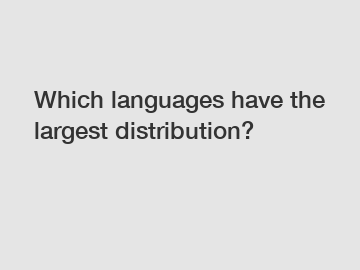Which languages have the largest distribution?
Which languages have the largest distribution?
English, Mandarin Chinese, and Spanish are often considered the three languages with the largest distribution in terms of native and non-native speakers. This conclusion is based on several factors, including the number of countries where these languages are spoken, the total number of speakers, and their prevalence in international communication. Let's delve deeper into the reasons behind this and explore the significance and impact of these widely spoken languages.
The first language, English, has positioned itself as a global lingua franca due to the historical and cultural influence of the British Empire and later the United States. Currently, English is spoken as a first language by around 360 million people and as a second language by over a billion individuals worldwide. Its widespread use can be attributed to various reasons, such as the influence of English-speaking media, the dominance of English in international business and science, and the popularity of English language learning programs. Consequently, English has become a vital communication tool for people from different linguistic backgrounds, facilitating global connectivity and fostering cultural exchange.

The second language, Mandarin Chinese, boasts the highest number of native speakers, with over 1.3 billion people speaking it as their first language. Its distribution is primarily concentrated in China, Singapore, Taiwan, and other regions with significant Chinese populations. The global influence of Mandarin Chinese is reinforced by China's economic growth and its emergence as a major player in international affairs. As China's political and economic influence expands, Mandarin Chinese is increasingly being studied and recognized as a language of business and diplomacy. Its prevalence extends beyond its native speakers, with many non-native learners showing interest in acquiring this language to tap into China's growing market and cultural heritage.
Lastly, Spanish, spoken by approximately 460 million as a first language, enjoys a wide distribution across Latin America, Spain, and parts of the United States. It is noteworthy that Spanish is the second most commonly spoken language in the world after Mandarin Chinese. The prevalence of Spanish can be attributed both to historical factors, such as the colonization of Latin America by Spanish-speaking countries, and to modern influences, such as the extensive reach of Spanish-language media and the growing Hispanic population in the United States. Spanish has gained significance as a major language of commerce, tourism, and cultural expression, making it essential for global communication.
In conclusion, English, Mandarin Chinese, and Spanish have the largest distribution among languages due to historical, economic, and cultural factors. These languages facilitate effective communication among people from diverse backgrounds and play significant roles in various aspects of international relations. As globalization continues to connect people around the world, proficiency in these languages will likely remain valuable, opening up new opportunities and enhancing intercultural understanding.
If you are looking for more details, kindly visit monitor for conference room, HDMI 4k Video Wall Controller, Discussion System.
173
0
0


Comments
All Comments (0)